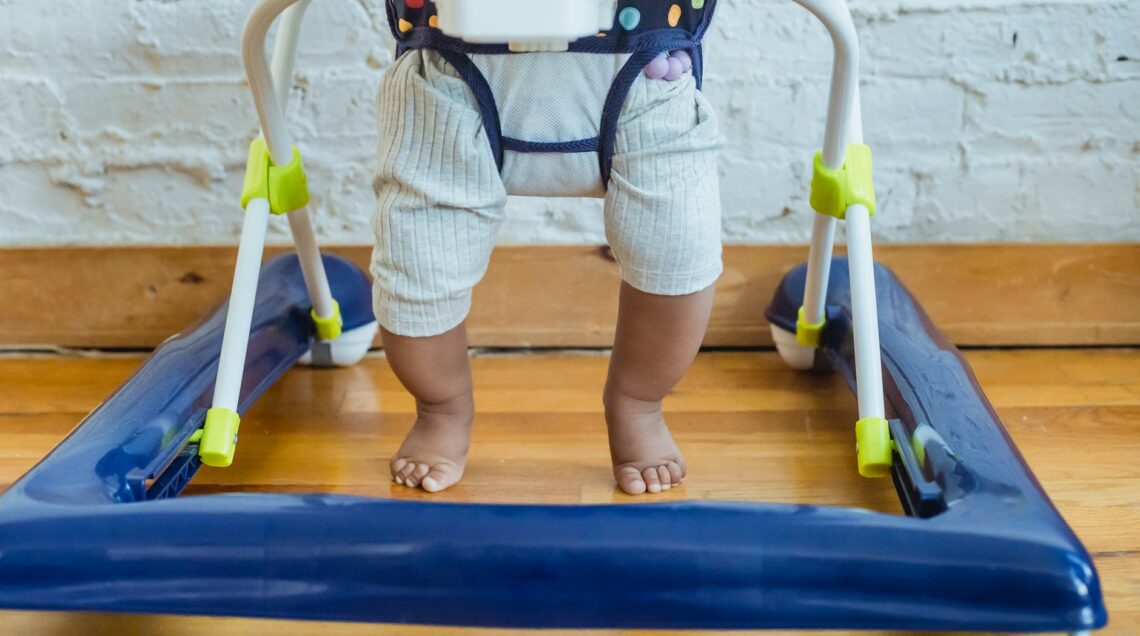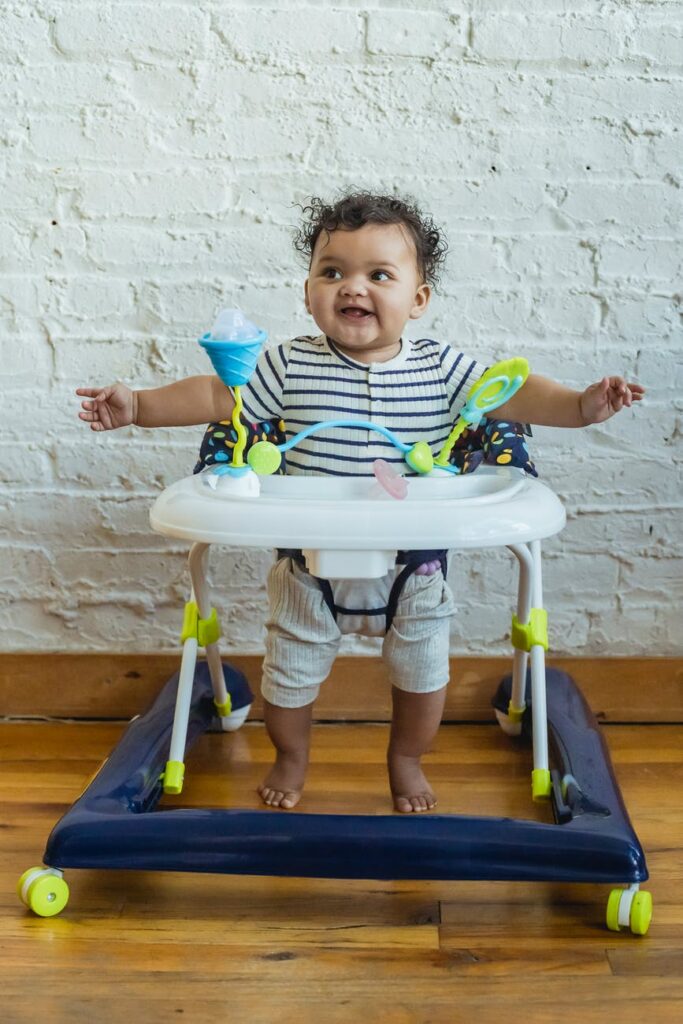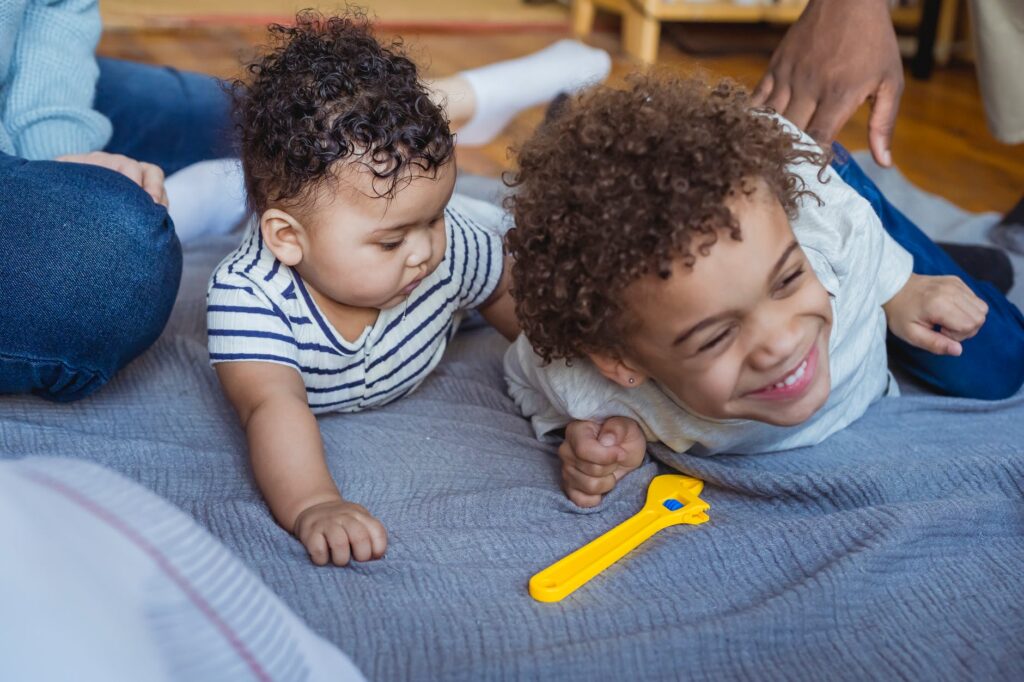
Could That Bouncy Seat Be Doing More Harm Than Good?
What do most busy moms needing to get a few things done and still make sure the baby is safe do?
They put the baby in the bouncy seat, the Bumbo, or the walker, right? These devices are meant to keep the baby safe after all, right?

Could that bouncy seat or exersaucer actually be harming your child? The short answer is, yes! These “tools” can be doing more harm than good. So how do you manage to get things done and make sure your baby is safe and developing properly? I have a few tips to help you accomplish everything you need to, but also provide the best environment for your child!
As a therapist, I see all too often the effects of a baby spending too much time in these types of devices. I see children that experience “container baby syndrome” (CBS), also known as “bucket babies.” CBS is a collection of movement disorders, behavior disorders, and other problems that are the result of the infant spending too much time in a contained space. These infants are being referred to as “bucket babies” or “container babies.” They are often spending most of their waking and sleeping hours in some type of container. They are not getting the opportunity to spend time on the floor, moving through the important motor milestones and developing muscular strength in their head, trunk, neck, and shoulders. It is also limiting their cognitive and social emotional development by not learning to explore and deal with challenging situations.

So what is considered a container? Any type of device that reduces or limits a baby’s movement and/or keeps them on their back.
Here is a list of some containers, but because there are always new innovations coming out for babies, there may be others that are not listed.
- Bouncy seats
- Exersaucers
- Car seats
- Bumbo seats
- Play gyms
- Nursing cushions
- Jumpers
- Vibrating chairs
- Swings
- Walkers
- Strollers
So how does this start? Well it is often well-intentioned parents that place the baby in a bouncy seat or car seat. They place them there to keep their child safe when they are not in their arms or if they are unable to pay close attention to the child. As the child gets comfortable in these types of devices, it is more difficult for them to be comfortable having to exert effort in attaining different developmental positions, such as belly time, rolling, sitting.

When a baby is learning how to use their body to move and it is challenging for them, they are building strength in their muscles and improving their coping skills. The less comfortable they are, the more they cry when placed in these positions. They are struggling, which results in the parents picking them back up and putting them in the container. When they were in the container, they were happy and content. The parent has truly the most loving intentions and only wants the best for their baby.
Unfortunately this can lead to a whole host of problems including but not limited to :
- Sensory Processing Disorder
- Flat head or deformity of head, face, spine, and joints
- Delayed development of motor milestones
- Decrease in strength and coordination
- Behavior problems
- Speech disorders
- Delayed cognitive development
- Poor eye-hand coordination and visual motor skills
- Attention Deficit Hyperactivity Disorder
- Learning disorders
- Obesity
Some people how much time exactly does their baby have to be in one of these devices for this to happen. While there is no set amount of time, a good rule of thumb is no more than 20-30 minutes a couple of times a day, provided the child is getting several hours of play on the floor.
Save these devices for when you need to shower or cook. Babies need to play to learn and to grow their minds and cognitive skills. This type of play needs to happen on the floor.
I know, the floor? Yup, on the floor.
Some of you may be thinking, “But we have dogs and older siblings that are going to trample the poor child!”

Your dog and kids may surprise you with how gentle they are around the baby. I know we had a 140lb cane corso who was a gentle giant and so patient with my two babies when they were little, but every dog and child is different so make sure you take precautions for your specific situation.
Here are some ideas that can help create spaces that you feel comfortable with and that can help you limit the amount of time your child spends in a “container”
- Use a blanket or foam mats (like this one) to create space for them to play
- Place dogs behind a baby gate when engaging in floor play
- Use a foldable baby gate for the play area to keep baby safe from animals or siblings that may not be paying attention during their own play
- Let older siblings know that the baby is on the floor and remind them to be careful around them
- Sit on the floor and play with the baby — this will motivate the baby to engage with toys and begin to communicate with you
- Place the baby next to you on the floor if you need to work at a desk from home or complete some tasks while seated
- Put a few toys just out of reach for the baby so they can engage with them and try to start rolling to them
- Use body wraps or slings to hold the baby while you are cleaning or doing tasks that you need to be hands free for. The movement is very good for young infants and they are used to it from being in the womb during pregnancy
- Set a timer for when you are placing them in a container so you don’t lose track of time.
- For a child that is learning to sit up, use a Boppy cushion and pillows around them to keep them safe and from hitting their head
Please note: If you are going to put your baby on their belly, it is important to have close supervision during that time and make sure your baby is awake.

The more time your child spends on the floor, the more comfortable they will be and you will watch how strong they become. So please use these containers sparingly and only for when you know you absolutely need to!
Do you have any other tips for entertaining your child so you can get some work done? What has worked for you (or what hasn’t)?

